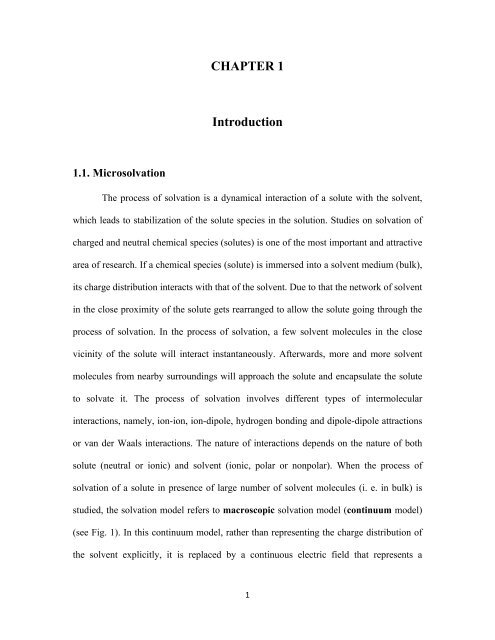CHEM01200604005 A. K. Pathak - Homi Bhabha National Institute
CHEM01200604005 A. K. Pathak - Homi Bhabha National Institute
CHEM01200604005 A. K. Pathak - Homi Bhabha National Institute
Create successful ePaper yourself
Turn your PDF publications into a flip-book with our unique Google optimized e-Paper software.
CHAPTER 1<br />
Introduction<br />
1.1. Microsolvation<br />
The process of solvation is a dynamical interaction of a solute with the solvent,<br />
which leads to stabilization of the solute species in the solution. Studies on solvation of<br />
charged and neutral chemical species (solutes) is one of the most important and attractive<br />
area of research. If a chemical species (solute) is immersed into a solvent medium (bulk),<br />
its charge distribution interacts with that of the solvent. Due to that the network of solvent<br />
in the close proximity of the solute gets rearranged to allow the solute going through the<br />
process of solvation. In the process of solvation, a few solvent molecules in the close<br />
vicinity of the solute will interact instantaneously. Afterwards, more and more solvent<br />
molecules from nearby surroundings will approach the solute and encapsulate the solute<br />
to solvate it. The process of solvation involves different types of intermolecular<br />
interactions, namely, ion-ion, ion-dipole, hydrogen bonding and dipole-dipole attractions<br />
or van der Waals interactions. The nature of interactions depends on the nature of both<br />
solute (neutral or ionic) and solvent (ionic, polar or nonpolar). When the process of<br />
solvation of a solute in presence of large number of solvent molecules (i. e. in bulk) is<br />
studied, the solvation model refers to macroscopic solvation model (continuum model)<br />
(see Fig. 1). In this continuum model, rather than representing the charge distribution of<br />
the solvent explicitly, it is replaced by a continuous electric field that represents a<br />
1
















